Students can Download Bio Botany Chapter 14 Respiration Questions and Answers, Notes Pdf, Samacheer Kalvi 11th Bio Botany Book Solutions Guide Pdf helps you to revise the complete Tamilnadu State Board New Syllabus and score more marks in your examinations.
Tamilnadu Samacheer Kalvi 11th Bio Botany Solutions Chapter 14 Respiration
Samacheer Kalvi 11th Bio Botany Respiration Text Book Back Questions and Answers
Question 1.
The number of ATP molecules formed by complete oxidation of one molecule of pyruvic acid is:
(a) 12
(b) 13
(c) 14
(d) 15
Answer:
(a) 12
Question 2.
During oxidation of two molecules of cytosolic NADH + H+, number of ATP molecules produced in plants are:
(a) 3
(b) 4
(c) 6
(d) 8
Answer:
(c) 6
![]()
Question 3.
The compound which links glycolysis and Krebs cycle is:
(a) succinic acid
(b) pyruvic acid
(c) acetyl CoA
(d) citric acid
Answer:
(c) acetyl CoA
Question 4.
Assertion (A): Oxidative phosphorylation takes place during the electron transport chain in mitochondria.
Reason (R): Succinyl CoA is phosphorylated into succinic acid by substrate phosphorylation.
(a) A and R is correct. R is correct explanation of A
(b) A and R is correct but R is not the correct explanation of A
(c) A is correct but R is wrong
(d) A and R is wrong.
Answer:
(a) A and R is correct. R is correct explanation of A
Question 5.
Which of the following reaction is not . involved in Krebs cycle.
(a) Shifting of phosphate from 3C to 2C
(b) Splitting of Fructose 1,6 bisphosphate of into two molecules 3C compounds.
(c) Dephosphorylation from the substrates
(d) All of these
Answer:
(d) All of these
Question 6.
What are enzymes involved in phosphorylation and dephosphorylation reactions in EMP pathway?
Answer:
(i) Enzymes involved phosphorylation in EMP pathway:
- Hexokinase
- Phospho – fructokinase
- Glyceraldehyde – 3 – phosphate dehydrogenase
(ii) Enzymes involved in dephosphorylation in EMP pathway:
- Phospho glycerate kinase,
- Pyruvate kinase
Question 7.
Respiratory quotient is zero in succulent plants. Why?
Answer:
In some succulent plants like Opuntia, Bryophyllum carbohydrates are partially oxidised to organic acid, particularly malic acid without corresponding release of CO2 but O2 is consumed hence the RQ value will be zero.
![]()
Question 8.
Explain the reactions taking place in mitochondrial inner membrane.
Answer:
In plants, an additional NADH dehydrogenase (External) complex is present on the outer surface of inner membrane of mitochondria which can oxidise cytosolic NADH + H+. Ubiquinone (UQ) or Coenzyme Quinone (Co Q) is a small, lipid soluble electron, proton carrier located within the inner membrane of mitochondria.
Question 9.
What is the name of alternate way of glucose breakdown? Explain the process involved in it?
Answer:
During respiration breakdown of glucose in cytosol occurs both by glycolysis (about 2 / 3) as well as by oxidative pentose phosphate pathway (about 1 / 3). Pentose phosphate pathway was described by Warburg, Dickens and Lipmann (1938). Hence, it is also called Warburg – Dickens – Lipmann pathway. It takes place in cytoplasm of mature plant cells. It is an alternate way for breakdown of glucose.
It is also known as Hexose monophosphate shunt (HMP Shunt) or Direct Oxidative Pathway. It consists of two phases, oxidative phase and non – oxidative phase. The oxidative events convert six molecules of six carbon Glucose – 6 – phosphate to 6 molecules of five carbon sugar Ribulose – 5 phosphate with loss of 6CO2 molecules and generation of 12 NADPH + H+ (not NADH). The remaining reactions known as non – oxidative pathway, convert Ribulose – 5 – phosphate molecules to various intermediates such as Ribose – 5 – phosphate(5C), Xylulose – 5 – phosphate(5C), Glyceraldehyde – 3 – phosphate(3C), Sedoheptulose – 7 – Phosphate (7C), and Erythrose – 4 – phosphate (4C). Finally, five molecules of glucose – 6 – phosphate is regenerated. The overall reaction is:

The net result of complete oxidation of one glucose – 6 – phosphate yield 6CO2 and 12 NADPH + H+. The oxidative pentose phosphate pathway is controlled by glucose – 6 – phosphate dehydrogenase enzyme which is inhibited by high ratio of NADPH to NADP+.
Question 10.
How will you calculate net products of one sucrose molecule upon complete oxidation during aerobic respiration as per recent view?
Answer:
When the cost of transport of ATPs from matrix into the cytosol is considered, the number will be 2.5 ATPs for each NADH + H+ and 1.5 ATPs for each FADH2 oxidised during electron transport system. Therefore, in plant cells net yield of 30 ATP molecules for complete aerobic oxidation of one molecule of glucose. But in those animal cells (showing malate shuttle mechanism) net yield will be 32 ATP molecules. Since sucrose molecule gives, two molecules of glucose and net ATP in plant cell will be 30 × 2 = 60. In animal cell it will be 32 × 2 = 64.
Samacheer Kalvi 11th Bio Botany Respiration Additional Questions & Answers
I. Choose the correct answer (1 Mark)
Question 1.
The term respiration was coined by:
(a) Lamark
(b) Kerb
(c) Pepys
(d) Blackman
Answer:
(c) Pepys
![]()
Question 2.
In floating respiration the substrates are:
(a) carbohydrate or protein
(b) carbohydrate or fat
(c) protein or fat
(d) none of the above
Answer:
(b) carbohydrate or fat
Question 3.
The discovery of ATP was made by:
(a) Lipman
(b) Hans Adolt
(c) Warburg
(d) Karl Lohman
Answer:
(d) Karl Lohman
Question 4.
The end product of glycolysis is:
(a) pyruvate
(b) ethanol
(c) malate
(d) succinate
Answer:
(a) pyruvate
![]()
Question 5.
On hydrolysis, one molecule of ATP releases energy of:
(a) 8.2 K cal
(b) 32.3 kJ
(c) 7.3 K cal
(d) 7.8 K cal
Answer:
(c) 7.3 K cal
Question 6.
Which of the following is known as terminal oxidation:
(a) glycolysis
(b) electron transport chain
(c) Kreb’s cycle
(d) pyruvate oxidation
Answer:
(b) electron transport chain
Question 7.
Identify the link reaction:
(a) conversion of glucose into pyruvic acid
(b) conversion of glucose into ethanol
(c) conversion of acetyl CoA into CO2 and water
(d) conversion of pyruvic acid into acetyl coenzyme – A
Answer:
(d) conversion of pyruvic acid into acetyl coenzyme – A
![]()
Question 8.
Who was awarded Nobel prize in 1953 for the discovery of TCA cycle?
(a) Lipmann
(b) Hans Adolf Kreb
(c) Petermitchell
(d) Dickens
Answer:
(b) Hans Adolf Kreb
Question 9.
Kreb’s cycle is a:
(a) catabolic pathway
(b) anabolic pathway
(c) amphibolic pathway
(d) hydrolytic pathway
Answer:
(c) amphibolic pathway
Question 10.
Electron transport system during aerobic respiration takes place in:
(a) cytoplasm
(b) mitochondria
(c) chloroplast
(d) golgi apparatus
Answer:
(b) mitochondria
Question 11.
The oxidation of one molecule of NADH + H+ gives rise to:
(a) 2 ATP
(b) 3 ATP
(c) 4 ATP
(d) 2.5 ATP
Answer:
(b) 3 ATP
![]()
Question 12.
In aerobic prokaryotes each molecule of glucose produces:
(a) 36 ATP
(b) 32 ATP
(c) 34 ATP
(d) 38 ATP
Answer:
(d) 38 ATP
Question 13.
Cyanide acts as electron transport chain inhibitor by preventing:
(a) synthesis of ATP from ADP
(b) flow of electrons from NADH + H+
(c) flow of electrons from cytochrome a3 to O2
(d) oxidative phosphorylation
Answer:
(c) flow of electrons from cytochrome a3 to O2
Question 14.
Respiratory quotient for oleic acid is:
(a) 0.69
(b) 0.71
(c) 0.80
(d) 0.36
Answer:
(b) 0.71
Question 15.
End products of fermentation in yeast is:
(a) pyruvic acid and CO2
(b) lactic acid qnd CO2
(c) ethyl alcohol and CO2
(d) mixed acid and CO2
Answer:
(c) ethyl alcohol and CO2
Question 16.
The end products of mixed acid fermentation in enterobacteriaceae are:
(a) lactic acid, ethanol, formic acid, CO2 and H2
(b) lactic acid, formic acid and CO2
(c) lactic acid, ethanol, CO2 and O2
(d) ethanol, formic acid, CO2 and H2
Answer:
(a) lactic acid, ethanol, formic acid, CO2 and H2
![]()
Question 17.
The external factors that affect the respiration are:
(a) temperature, insufficient O2 and amount of protoplasm
(b) temperature, insufficient O2 and high concentration of CO2
(c) temperature, high concentration of CO2 and respiratory substrate
(d) temperature, high concentration of CO2 and amount of protoplasm
Answer:
(b) temperature, insufficient O2 and high concentration of CO2
Question 18.
Pentose phosphate pathway was described by:
(a) Pepys and Black man
(b) Kreb and Embden
(c) Warburg, Dickens and Lipmann
(d) Warburg and Pamas
Answer:
(c) Warburg, Dickens and Lipmann
Question 19.
The oxidative pentose phosphate pathway is controlled by the enzyme:
(a) glucose, 1, 6 diphosphate dehydrogenase
(b) glucose 6 phosphate dehydrogenase
(c) fructose – 6 – phosphate dehydrogenase
(d) none of the above
Answer:
(b) glucose 6 phosphate dehydrogenase
Question 20.
In pentose phosphate pathway the glucose – 6 – phosphate dehydrogenase enzyme is inhibited by high ratio of:
(a) FADH to FAD
(b) glucose to glucose – 6 – phosphate
(c) NADPH to NADP
(d) GTPH to GTP
Answer:
(c) NADPH to NADP
![]()
Question 21.
In plant tissue erythrose is used for the synthesis of:
(a) Erythromycin
(b) Xanthophill
(c) Erythrocin
(d) Arithocyanin
Answer:
(d) Arithocyanin
Question 22.
As per the recent view, when a glucose molecule is completely aerobically oxidised, the net yield of ATP in plant cell is:
(a) 38
(b) 36
(c) 30
(d) 32
Answer:
(c) 30
Question 23.
Identify the electron transport inhibitor:
(a) phosphophenol
(b) dinitrophenol
(c) xylene
(d) indol acetic acid
Answer:
(b) dinitrophenol
Question 24.
The phenomenon of climacteric is present in:
(a) banana
(b) coconut
(c) cauli flower
(d) brinjal
Answer:
(a) banana
![]()
Question 25.
Cyanide resistant respiration is known to generate heat in thermogenic tissues as high as:
(a) 35° C
(b) 38° C
(c) 40° C
(d) 51° C
Answer:
(d) 51° C
Question 26.
Match the following:
| Substrate |
RQ |
| A. Palmitic acid | (i) 1.6 |
| B. Oleic acid | (ii) 4.0 |
| C. Tartaric acid | (iii) 0.36 |
| D. Oxalic acid | (iv) 0.71 |
(a) A – (ii), B – (iii); C – (i); D – (iv)
(b) A – (iii), B – (iv); C – (i); D – (ii)
(c) A – (ii); B – (iv); C – (i); D – (iii)
(d) A – (iii); B – (i); C – (iv); D – (ii)
Answer:
(b) A – (iii), B – (iv); C – (i); D – (ii)
Question 27.
Indicate the correct statement:
(a) In Bryophyllum, carbohydrates are partially oxidised to organic acid
(b) In opuntia, the Respiratory Quotient value is 0.5
(c) Alcoholic fermentation takes place in enterobacteriaceae
(d) Muscles of vertebrate does not have lactate dehydrogenase enzyme
Answer:
(a) In Bryophyllum, carbohydrates are partially oxidised to organic acid
![]()
Question 28.
The order of aerobic respiration in plant cell is:
(a) glycolysis, Kreb’s cycle, pyruvate oxidation and electron transport chain
(b) glycolysis, pyruvate oxidate, Kreb’s cycle, electron transport chain
(c) pyruvate oxidation, glycolysis, Kreb’s cycle, electron transport chain
(d) none of the above order
Answer:
(b) glycolysis, pyruvate oxidate, Kreb’s cycle, electron transport chain
Question 29.
The complete reactions of glycolysis take place in:
(a) mitochondria
(b) cristae
(c) cytoplasm
(d) outer membrane of mitochondria
Answer:
(c) cytoplasm
Question 30.
The Co – enzyme quinone is a proton carrier located within:
(a) outer membrane of mitochondria
(b) cytoplasm
(c) inner membrane of mitochondria
(d) matrix of mitochondria
Answer:
(c) inner membrane of mitochondria
![]()
Question 31.
How many molecules of CO2 are produced during link reaction:
(a) 1
(b) 6
(c) 4
(d) 2
Answer:
(d) 2
Question 32.
In the case of ground nut, during seed germination they use:
(a) carbohydrate as respiratory substrate
(b) fat alone as respiratory substrate
(c) fat and protein as respiratory substrate
(d) protein alone as respiratory substrate
Answer:
(c) fat and protein as respiratory substrate
Question 33.
Lactic acid fermentation takes place in:
(a) yeast
(b) bacillus
(c) enterobacteriaceae
(d) none of the above
Answer:
(b) bacillus
![]()
Question 34.
The net result of complete oxidation of one glucose-6-phosphate in pentose phosphate pathway yield:
(a) 6 CO2 and 12 NADPH + H+
(b) 6 CO2 and 10 NADPH + H+
(c) 8 CO2 and 16 NADPH + H+
(d) 8 CO2 and 14 NADPH + H
Answer:
(a) 6 CO2 and 12 NADPH + H+
Question 35.
Ribose – 5 – phosphate and its derivatives are used in the synthesis of:
(a) lignin
(b) coenzyme A
(c) anthocyanin
(d) xanthophyll
Answer:
(b) coenzyme A
II. Answer the following (2 Marks)
Question 1.
Define respiration?
Answer:
Respiration is a biological process in which oxidation of various food substances like carbohydrates, proteins and fats take place and as a result of this, energy is produced where O2 is taken in and CO2 is liberated.
Question 2.
What is meant by protoplasmic respiration?
Answer:
Respiration utilizing protein as a respiratory substrate, it is called protoplasmic respiration. Protoplasmic respiration is rare and it depletes structural and functional proteins of protoplasm and liberates toxic ammonia.
![]()
Question 3.
What do you understand by compensation of point?
Answer:
The point at which CO2 released in respiration is exactly compensated by CO2 fixed in photosynthesis that means no net gaseous exchange takes place, it is called compensation point.
Question 4.
Explain briefly about aerobic respiration.
Answer:
Respiration occurring in the presence of oxygen is called aerobic respiration. During aerobic respiration, food materials like carbohydrates, fats and proteins are completely oxidised into CO2, H2O and energy is released.
Question 5.
What is anaerobic respiration?
Answer:
In the absence of molecular oxygen glucose is incompletely degraded into either ethyl alcohol or lactic acid. It includes two steps:
- Glycolysis
- Fermentation
Question 6.
What do you know about transition reaction?
Answer:
In aerobic respiration the pyruvate with coenzyme A is oxidatively decarboxylated into acetyl CoA by pyruvate dehydrogenase complex. This reaction is irreversible and produces two molecules of NADH + H+ and 2CO2. It is also called transition reaction or Link reaction.
![]()
Question 7.
Who is Sir Hans Adolf Krebs?
Answer:
Sir Hans Adolf Krebs was born in Germany on 25th August 1900. He was awarded Nobel Prize for his discovery of Citric acid cycle in Physiology in 1953.
Question 8.
Explain briefly about amphibolic pathway.
Answer:
Krebs cycle is primarily a catabolic pathway, but it provides precursors for various biosynthetic pathways thereby an anabolic pathway too. Hence, it is called amphibolic pathway.
Question 9.
Mention the role of NADH dehydrogenase enzyme in electron transport system.
Answer:
NADH dehydrogenase contains a flavoprotein (FMN) and associated with non – heme iron Sulphur protein (Fe – S). This complex is responsible for passing electrons and protons from mitochondrial NADH (Internal) to Ubiquinone (UQ).
![]()
Question 10.
What is oxidative phosphorylation?
Answer:
The transfer of electrons from reduced coenzyme NADH to oxygen via complexes I to IV is coupled to the synthesis of ATP from ADP and inorganic phosphate (Pi) which is called Oxidative phosphorylation.
Question 11.
Mention any two electron transport chain inhibitors.
Answer:
Two electron transport chain inhibitors:
- 2, 4 DNP (Dinitrophenol) – It prevents synthesis of ATP from ADP, as it directs electrons from Co Q to O2.
- Cyanide – It prevents flow of electrons from Cytochrome a3 to O2.
Question 12.
Define respiratory quotient.
Answer:
The ratio of volume of carbon dioxide given out and volume of oxygen taken in during respiration is called Respiratory Quotient.
Question 13.
What are the significances of Respiratory Quotient?
Answer:
The significances of Respiratory Quotient:
- RQ value indicates which type of respiration occurs in living cells, either aerobic or anaerobic.
- It also helps to know which type of respiratory substrate is involved.
![]()
Question 14.
Explain the term alcoholic fermentation.
Answer:
The cells of roots in water logged soil respire by alcoholic fermentation because of lack of oxygen by converting pyruvic acid into ethyl alcohol and CO2. Many species of yeast (Saccharomyces) also respire anaerobically. This process takes place in two steps:

Question 15.
Mention any two industrial uses of alcoholic fermentation.
Answer:
Two industrial uses of alcoholic fermentation:
- In bakeries, it is used for preparing bread, cakes, biscuits.
- In beverage industries for preparing wine and alcoholic drinks.
Question 16.
What do you understand by the term mixed acid fermentation?
Answer:
This type of fermentation is a characteristic feature of Enterobacteriaceae and results in the formation of lactic acid, ethanol, formic acid and gases like CO2 and H2.
![]()
Question 17.
Mention any two internal factors, that affect the rate of respiration in plants.
Answer:
Two internal factors, that affect the rate of respiration in plants:
- The amount of protoplasm and its state of activity influence the rate of respiration.
- Concentration of respiratory substrate is proportional to the rate of respiration.
Question 18.
What is the control mechanism of pentose phosphate pathway?
Answer:
The oxidative pentose phosphate pathway is controlled by glucose-6-phosphate dehydrogenase enzyme which is inhibited by high ratio of NADPH to NADP+.
Question 19.
Write down any two significance of pentose phosphate pathway.
Answer:
Two significance of pentose phosphate pathway:
- HMP shunt is associated with the generation of two important products,
- Coenzyme NADPH generated is used for reductive biosynthesis and counter damaging the effects of oxygen free radicals.
III. Answer the following (3 Marks)
Question 1.
In biosphere how do plants and animals are complementary systems, which are integrated to sustain life?
Answer:
In plants, oxygen enters through the stomata and it is transported to cells, where oxygen is utilized for energy production. Plants require carbon dioxide to survive, to produce carbohydrates and to release oxygen through photosynthesis, these oxygen molecules are inhaled by human through the nose, which reaches the lungs where oxygen is transported through the blood and it reaches cells. Cellular respiration takes place inside or the cell for obtaining energy.
![]()
Question 2.
What will happen, when you sleep under a tree during night time?
Answer:
If you are sleeping under a tree during night time you will feel difficulty in breathing. During night, plants take up oxygen and release carbon dioxide and as a result carbon dioxide will be abundant around the tree
Question 3.
What are the factors associated with compensation point in respiration?
Answer:
The two common factors associated with compensation point are CO2 and light. Based on this there are two types of compensation point. They are CO2 compensation point and light compensation point. C3 plants have compensation points ranging from 40 – 60 ppm (parts per million) CO2 while those of C4 plants ranges from 1 – 5 ppm CO2.
Question 4.
Why do you call ATP as universal energy currency of cell?
Answer:
ATP is a nucleotide consisting of a base- adenine, a pentose sugar – ribose and three phosphate groups. Out of three phosphate groups the last two are attached by high energy rich bonds. On hydrolysis, it releases energy (7.3 K cal or 30.6 KJ / ATP) and it is found in all living cells and hence it is called universal energy currency of the cell.
Question 5.
What is a redox reaction?
Answer:
NAD+ + 2e– + 2H+ → NADH + H+
FAD + 2e– + 2H+ → FADH2
When NAD+ (Nicotinamide Adenine Dinucleotide – oxidised form) and FAD (Flavin Adenine Dinucleotide) pick up electrons and one or two hydrogen ions (protons), they get reduced to NADH + H+ and FADH2 respectively. When they drop electrons and hydrogen off they go back to their original form. The reaction in which NAD+ and FAD gain (reduction) or f lose (oxidation) electrons are called redox reaction (Oxidation reduction reaction). These reactions are important in cellular respiration.
![]()
Question 6.
Write down any three differences between aerobic and anaerobic respiration.
Answer:
Aerobic respiration:
- It occurs in all living cells of higher organisms.
- It requires oxygen for breaking the respiratory substrate.
- The end products are CO2 and H2O.
Anaerobic Respiration:
- It occurs yeast and some bacteria.
- Oxygen is not required for breaking the respiratory substrate.
- The end products are alcohol, and CO2 (or) lactic acid.
Question 7.
Mention the significance of Kreb’s cycle.
Answer:
The significance of Kreb’s cycle:
- TCA cycle is to provide energy in the form of ATP for metabolism in plants.
- It provides carbon skeleton or raw material for various anabolic processes.
- Many intermediates of TCA cycle are further metabolised to produce amino acids, proteins and nucleic acids.
- Succinyl CoA is raw material for formation of chlorophylls, cytochrome, phytochrome and other pyrrole substances.
- α – ketoglutarate and oxaloacetate undergo reductive amination and produce amino acids.
- It acts as metabolic sink which plays a central role in intermediary metabolism.
Question 8.
Derive the respiratory quotient for carbohydrate as substrate in oxidative metabolism.
Answer:
The respiratory substrate is a carbohydrate, it will be completely oxidised in aerobic respiration and the value of the RQ will be equal to unity.

Question 9.
Write down the characteristic of Anaerobic respiration.
Answer:
The characteristic of Anaerobic respiration:
- Anaerobic respiration is less efficient than the aerobic respiration.
- Limited number of ATP molecules is generated per glucose molecule.
- It is characterized by the production of CO2 and it is used for Carbon fixation in photosynthesis.
Question 10.
Distinguish between glycolysis and fermentation.
Answer:
Glycolysis:
- Glucose is converted into pyruvic acid.
- It takes place in the presence or absence of oxygen.
- Net gain is 2ATR
- 2 NADH + H+ molecules are produced.
Fermentation:
- Starts from pyruvic acid and is converted into alcohol or lactic acid.
- It takes place in the absence of oxygen.
- No net gain of ATP molecules.
- 2 NADH + H+ molecules are utilised.
![]()
Question 11.
Write down any three external factors, that affect respiration in plants.
Answer:
Three external factors, that affect respiration in plants:
- Optimum temperature for respiration is 30°C. At low temperatures and very high temperatures rate of respiration decreases.
- When sufficient amount of O2 is available the rate of aerobic respiration will be optimum and anaerobic respiration is completely stopped. This is called Extinction point.
- High concentration of CO2 reduces the rate of respiration
Question 12.
How alcoholic beverages like beer and wine is made?
Answer:
The conversion of pyruvate to ethanol takes place in malted barley and grapes through fermentation. Yeasts carryout this process under anaerobic conditions and this Conversion increases ethanol concentration. If the concentration increases, it’s toxic effect kills yeast cells .and the left out is called beer and wine respectively.
IV. Answer the following (5 Marks)
Question 1.
Give the schematic representation of glycolysis or EMP pathway.
Answer:
The schematic representation of glycolysis or EMP pathway:
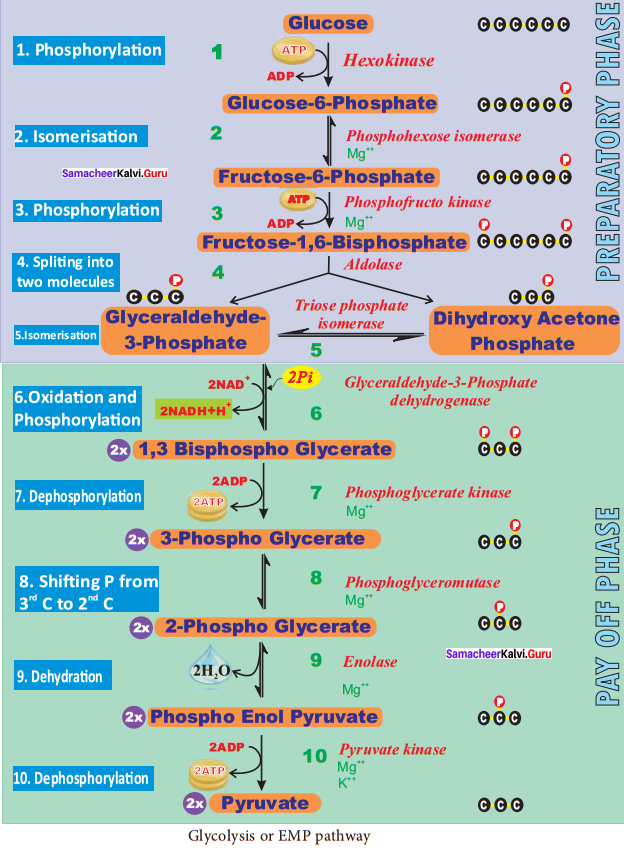
Question 2.
Write down the biochemical events in Kreb’s cycle.
Answer:
The biochemical events in Kreb’s cycle:
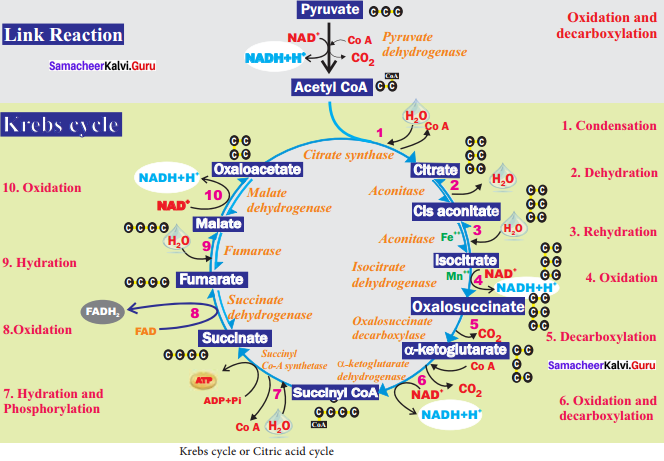
Question 3.
Mention the schematic diagram of the various steps involved in pentose phosphate pathway.
Answer:
The schematic diagram of the various steps involved in pentose phosphate pathway:
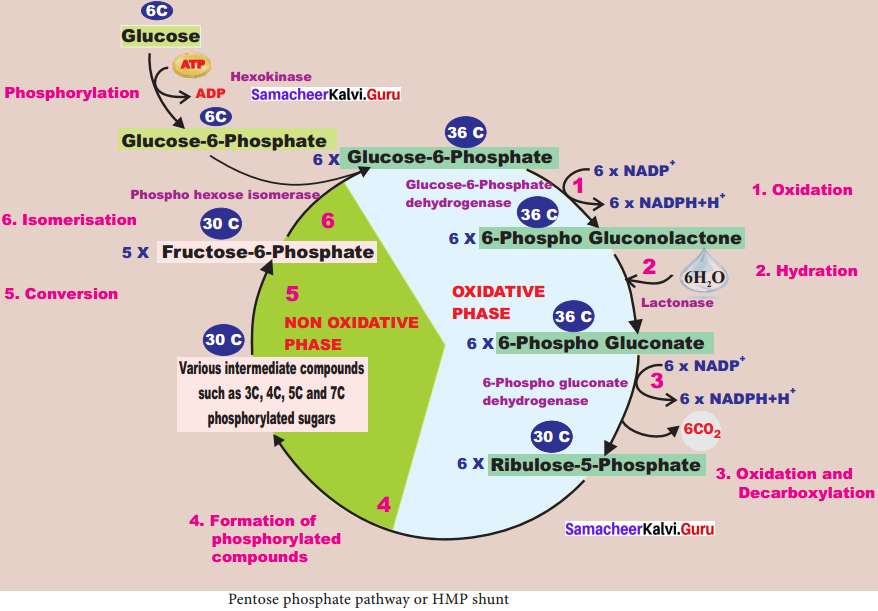
Question 4.
Describe the events in electron transport chain in plant cell.
Answer:
During glycolysis, link reaction and Krebs cycle the respiratory substrates are oxidised at several steps and as a result many reduced coenzymes NADH + H+ and FADH2 are produced. These reduced coenzymes are transported to inner membrane of mitochondria and are converted back to their oxidised forms produce electrons and protons. In mitochondria, the inner membrane is folded in the form of finger projections towards the matrix called cristae.
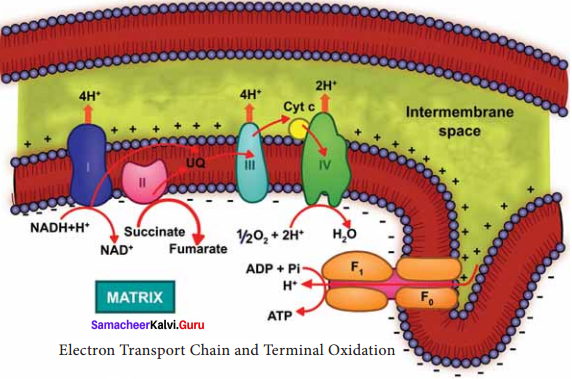
In cristae many oxysomes (F1 particles) are present which have election transport carriers are present. According to Peter Mitchell’s Chemiosmotic theory this electron transport is coupled to ATP synthesis. Electron and hydrogen (proton) transport takes place across four multiprotein complexes (I – IV). They are
(i) Complex – I (NADH dehydrogenase: It contains a flavoprotein (FMN) and associated with non – heme iron Sulphur protein (Fe – S). This complex is responsible for passing electrons and protons from mitochondrial NADH (Internal) to Ubiquinone (UQ).
NADH + H+ + UQ ⇌ NAD+ + UQH2
In plants, an additional NADH dehydrogenase (External) complex is present on the outer surface of inner membrane of mitochondria which can oxidise cytosolic NADH + H+ Ubiquinone (UQ) or Coenzyme Quinone (Co Q) is a small, lipid soluble electron, proton carrier located within the inner membrane of mitochondria.
(ii) Complex – II (Succinic dehydrogenase): It contains FAD flavoprotein is associated with non – heme iron Sulphur (Fe – S) protein. This complex receives electrons and protons from succinate in Krebs cycle and is converted into fumarate and passes to ubiquinone.
Succinate + UQ → Fumarate + UQH2
(iii) Complex – III (Cytochrome bc1 complex): This complex oxidises reduced ubiquinone (ubiquinol) and transfers the electrons through Cytochrome bc1 Complex (Iron Sulphur center bc1 complex) to cytochrome c. Cytochrome c is a small protein attached to the outer surface of inner membrane and act as a. mobile carrier to transfer electrons between complex III to complex IV.
UQH2 + 2Cyt coxidised ⇌ UQ + 2Cyt creduced + 2H+
(iv) Complex IV (Cytochrome c oxidase): This complex contains two copper centers (A and B) and cytochromes a and as. Complex IV is the terminal oxidase and brings about the reduction of 1/2 O2 to H2O. Two protons are needed to form a molecule of H2O (terminal oxidation).
2Cyt coxidised + 2H+ + 1/2 O2 ⇌ 2Cyt creduced + H2O
The transfer of electrons from reduced coenzyme NADH to oxygen via complexes I to IV is coupled to the synthesis of ATP from ADP and inorganic phosphate (Pi) which is called Oxidative phosphorylation. The F0F1 – ATP synthase (also called complex V) consists of F0 and F1. F1 converts ADP and Pi to ATP and is attached to the matrix side of the inner membrane. F0 is present in inner membrane and acts as a channel through which protons come into matrix.
Oxidation of one molecule of NADH + H+ gives rise to 3 molecules of ATP and oxidation of one molecule FADH2 produces 2 molecules of ATP within a mitochondrion. But cytoplasmic NADH + H+ yields only two ATPs through external NADH dehydrogenase. Therefore, two reduced coenzyme (NADH + H+) molecules from glycolysis being extra mitochondrial will yield 2 × 2 = 4 ATP molecules instead of 6 ATPs. The Mechanism of mitochondrial ATP synthesis is based on Chemiosmotic hypothesis.
According to this theory electron carriers present in the inner mitochondrial membrane allow for the transfer of protons (H+). For the production of single ATP, 3 protons (H+) are needed. The terminal oxidation of external NADH bypasses the first phosphorylation site and hence only two ATP molecules are produced per external NADH oxidised through However, in those animal tissues in which malate shuttle mechanism is present, the oxidation of external NADH will yield almost 3 ATP molecules.
Complete oxidation of a glucose molecule in aerobic respiration results in the net gain of 36 ATP molecules in plants. Since huge amount of energy is generated in mitochondria in the form of ATP molecules they are called ‘power house of the cell’. In the case of aerobic prokaryotes due to lack of mitochondria each molecule of glucose produces 38 ATP molecules.
Question 5.
Define respiratory quotient. Explain the derivation of respiratory quotient for various substrates oxidised :
Answer:
The ratio of volume of carbon dioxide given out and volume of oxygen taken in during respiration is called Respiratory Quotient or Respiratory ratio. RQ value depends, upon respiratory substrates and their oxidation.
![]()
(i) The respiratory substrate is a carbohydrate, it will be completely oxidised in aerobic respiration and the value of the RQ will be equal to unity.
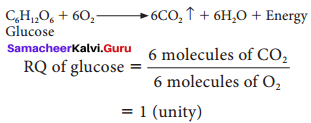
(ii) If the respiratory substrate is . a carbohydrate it will be incompletely oxidised when it goes through anaerobic respiration and the RQ value will be infinity.
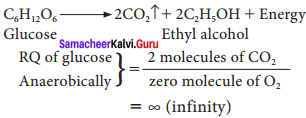
(iii) In some succulent plants like Opuntia, Bryophyllum carbohydrates are partially oxidised to organic acid, particularly malic acid without corresponding release of CO2 but O2 is consumed hence the RQ value will be zero.
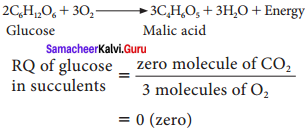
(iv) When respiratory substrate is protein or fat, then RQ will be less than unity.
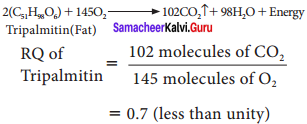
(v) When respiratory substrate is an organic acid the value of RQ will be more than unity.
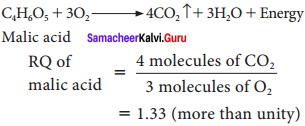
Question 6.
Describe an experiment to demonstrate the production of CO2 in aerobic respiration.
Answer:
Take small quantity of any seed (groundnut or bean seeds) and allow them to germinate by imbibing them. While they are germinating place them in a conical flask. A small glass tube containing 4 ml of freshly prepared Potassium hydroxide (KOH) solution is hung into the conical flask with the help of a thread and tightly close the one holed cork. Take a bent glass tube, the shorter end of which is inserted into the conical flask through the hole in the cork, while the longer end is dipped in a beaker containing water.
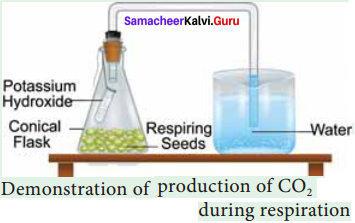
Observe the position of initial water level in bent glass tube. This experimental setup is kept for two hours and the seeds were allowed to germinate. After two hours, the level of water rises in the glass tube. It is because, the CO2 evolved during aerobic respiration by germinating seeds will be absorbed by KOH solution and the level of water will rise in the glass tube.
CO2 + 2KOH → K2CO3 + H2O
In the case of groundnut or bean seeds, the rise of water is relatively lesser because these seeds use fat and proteins as respiratory substrate and release a very small amount of CO2. But in the case of wheat grains, the rise in water level is greater because they use carbohydrate as respiratory substrate. When carbohydrates are used as substrate, equal amounts of CO2 and O2 are evolved and consumed.
Textbook Page No. 145
Question 1.
How many ATP molecules are produced from one sucrose molecule?
Answer:
One sucrose molecules gives rise to two glucose molecules. The net production of ATP during complete oxidation of one glucose molecule in plant cell is 36 ATP. Therefore one sucrose molecule yields 36 x 2 = 72 ATP molecules.
As per recent view in plants cells, one molecules of glucose, after complete aerobic oxidation yields only 30 ATP molecules and hence one sucrose molecule yield only 30 x 2 = 60 ATP molecules.
Textbook Page No. 156
Question 1.
Why Microorganisms respire anaerobically?
Answer:
Some of the microorganism live in environments devoid of oxygen and they have to adopt themselves in anoxic condition. Hence they respire anaerobically and they are called anaerobic microbes.
![]()
Question 2.
Does anaerobic respiration take place in higher plants?
Answer:
Anaerobic respiration some time occur in the root of some water – logged plants.